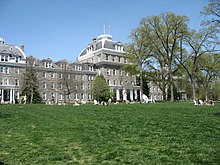Delaware Valley Greater Philadelphia Philadelphia metropolitan area Philadelphia-Camden-Wilmington, PA-NJ-DE-MD CSA | ||
|---|---|---|
 Center City Philadelphia (in background) and the Schuylkill River (on left) as seen from South Street Bridge in July 2016 | ||
 Philadelphia–Reading–Camden, PA–NJ–DE–MD CSA
| ||
| Country | | |
| States | | |
| Principal city | Philadelphia | |
| Satellite cities and towns | ||
| Area | ||
| • Urban | 1,981.4 sq mi (5,131.7 km2) | |
| • Metro | 5,118 sq mi (13,256 km2) | |
| Elevation | 0 - 1,080 ft (0 - 329 m) | |
| Population (2021 est.) | ||
| • Urban | 5,441,567 (5th) | |
| • Metro density | 1,217.00/sq mi (469.89/km2) | |
| • MSA | 6,228,601 (7th) | |
| • CSA | 7,366,346 (9th) | |
| MSA/CSA = 2021, Urban = 2010 | ||
| GDP | ||
| • MSA | $518.5 billion (2022) | |
| Time zone | UTC−5 (EST) | |
| • Summer (DST) | UTC−4 (EST) | |
| Area codes | 215/267/445, 302, 410/443/667, 609/640, 610/484/835, 717/223, 856 | |
The Delaware Valley, sometimes referred to as Greater Philadelphia, Philadelphia metropolitan area, or Philadelphia tri-state area, and locally and colloquially referred to as Philly-Jersey-Delaware, is a major metropolitan area in Northeast United States that centers on Philadelphia, the 6th-most populous city in the United States, and spans part of four states: Southeastern Pennsylvania, Southern New Jersey, Northern Delaware, and the northern Eastern Shore of Maryland, though it is sometimes considered a tri-state region if northeast Maryland is excluded from the definition. With a core of metropolitan statistical area population of 6.288 million residents and a combined statistical area population of 7.366 million (as of the 2020 census), Delaware Valley is the eighth-largest metropolitan region in the United States and the 68th-largest metropolitan region in the world.
Contents
- Geography and population
- Metropolitan statistical area (MSA)
- Combined statistical area (CSA)
- Statistical history
- Climate Types
- Subregions
- Largest municipalities
- Climate
- Economy
- Delaware Regional Planning Commission
- Colonial history
- Transportation
- Rail
- Bus service
- Major highways
- Airports
- Ferry
- Colleges and universities
- Delaware 2
- Maryland 2
- New Jersey 2
- Pennsylvania 2
- Culture
- Characteristics
- Sports teams
- Media
- Area codes
- Politics
- Congressional districts
- See also
- Notes
- References
- Further reading
- External links
In addition to Philadelphia, other major population centers in the Delaware Valley include Reading, Upper Darby Township, and Chester in Pennsylvania; Atlantic City, Camden, Vineland, and Cherry Hill in South Jersey; and Wilmington and Dover in Delaware. As of 2022, the Philadelphia metropolitan area's gross domestic product (GDP) exceeds US$518 billion, making it the tenth-largest metropolitan economy in the nation. [3]
The Delaware Valley has been influential in the nation's history and economy and home to many people and sites significant to American culture, history, and politics. Philadelphia is sometimes known as "The Birthplace of America" [4] in reference to its role as the revolutionary capital during the colonial era in which the Second Continental Congress gathered at Independence Hall and unanimously adopted the Declaration of Independence, authorized the formation of the Continental Army, and appointed George Washington its commander to resist the British. After the Continental Army's victory, Philadelphia served as the nation's first capital for most of the 18th century until 1800, when construction of Washington, D.C. was completed. The U.S. Constitution, the world's longest-standing body of federal law, was ratified at Independence Hall in Philadelphia in 1789.
The Delaware Valley is one of the nation's leading regions for academia and academic research with a considerable number of globally-known and highly ranked universities, including the University of Pennsylvania, one of the nation's eight Ivy League universities. Other major universities and colleges in the region include Drexel University, Thomas Jefferson University, Rowan University, Villanova University, Saint Joseph's University, Temple University, Rutgers University–Camden, La Salle University, the University of Delaware, Stockton University, and others. [5]
Philadelphia and the Delaware Valley are a biotechnology hub. [6] As of 2024, metropolitan Philadelphia ranks as one of the Big Five U.S. venture capital hubs, facilitated by its proximity to both New York City's entrepreneurial and financial ecosystems and to the federal regulatory environment of Washington, D.C. [7] Elsewhere in the Delaware Valley, South Jersey has emerged as an East Coast epicenter for logistics and major warehouses. [8]
Culturally, the region is home to the dialect or accent known as Philadelphia English, shares a unique cuisine known as Philadelphia cuisine, has played a formidable role in popular music, and is known for having one of the nation's most passionate and devoted sports cultures centered around its five professional sports teams.







































